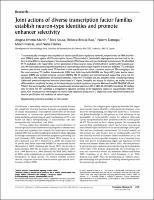Please use this identifier to cite or link to this item:
https://repositorio.usj.es/handle/123456789/901
| Title: | Joint actions of diverse transcription factor families establish neuron-type identities and promote enhancer selectivity |
| Authors: | Jimeno-Martín, Ángela


Sousa, Erick 
Brocal-Ruiz, Rebeca Daroqui, Noemi Maicas, Miren Flames, Nuria 

|
| Keywords: | Regulatory logic; Nervous-system; Gene-expression; Cell identity; Specification; Fate; Homolog; Code; Differentiation; Neurogenesis |
| Issue Date: | Mar-2022 |
| Citation: | Jimeno-Martín A, Sousa E, Brocal-Ruiz R, Daroqui N, Maicas M, Flames N. Joint actions of diverse transcription factor families establish neuron-type identities and promote enhancer selectivity. Genome Res. 2022 Mar;32(3):459-473. doi: 10.1101/gr.275623.121. |
| Abstract: | To systematically investigate the complexity of neuron specification regulatory networks, we performed an RNA interference (RNAi) screen against all 875 transcription factors (TFs) encoded in Caenorhabditis elegans genome and searched for defects in nine different neuron types of the monoaminergic (MA) superclass and two cholinergic motoneurons. We identified 91 TF candidates to be required for correct generation of these neuron types, of which 28 were confirmed by mutant analysis. We found that correct reporter expression in each individual neuron type requires at least nine different TFs. Individual neuron types do not usually share TFs involved in their specification but share a common pattern of TFs belonging to the five most common TF families: homeodomain (HD), basic helix loop helix (bHLH), zinc finger (ZF), basic leucine zipper domain (bZIP), and nuclear hormone receptors (NHR). HD TF members are overrepresented, supporting a key role for this family in the establishment of neuronal identities. These five TF families are also prevalent when considering mutant alleles with previously reported neuronal phenotypes in C. elegans, Drosophila, and mouse. In addition, we studied terminal differentiation complexity focusing on the dopaminergic terminal regulatory program. We found two HD TFs (UNC-62 and VAB-3) that work together with known dopaminergic terminal selectors (AST-1, CEH-43, CEH-20). Combined TF binding sites for these five TFs constitute a cis-regulatory signature enriched in the regulatory regions of dopaminergic effector genes. Our results provide new insights on neuron-type regulatory programs in C. elegans that could help better understand neuron specification and evolution of neuron types. |
| URI: | https://repositorio.usj.es/handle/123456789/901 |
| ISSN: | 1088-9051 |
| Appears in Collections: | Artículos de revistas |
Files in This Item:
| File | Description | Size | Format | |
|---|---|---|---|---|
| Joint actions of diverse transcription factor families.pdf | 9,69 MB | Adobe PDF |  View/Open |
This item is licensed under a Creative Commons License

